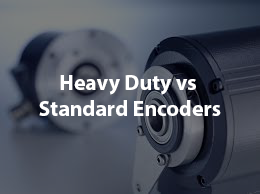An encoder is a vital component in modern automation systems, converting mechanical motion into electrical signals that provide real-time feedback on position, speed, and direction. Whether you’re working in manufacturing, robotics, or heavy industry, choosing the right type of encoder, heavy-duty or standard, can significantly impact system performance, reliability, and maintenance costs.
What Does Encoder Do?
Encoders are used to monitor and control motion in automated systems. They translate mechanical movement into digital signals that machines use to make precise adjustments. From robotic arms to conveyor belts, encoders ensure accuracy, efficiency, and safety. Learn more about the working principles of an encoder.
However, not all encoders are built the same. The choice between heavy-duty and standard encoders depends on environmental conditions, mechanical stress, and application requirements.
Heavy-Duty Encoders: Built for Harsh Conditions
1. Rugged Design and Materials
Heavy-duty encoders are engineered for demanding industrial environments. They feature robust housings made from stainless steel or reinforced aluminium, sealed bearings, and strong shafts capable of withstanding high torque and mechanical loads.
These encoders are ideal for industries like:
- Mining and quarrying
- Steel production
- Oil and gas
- Heavy machinery and cranes
2. Superior Environmental Resistance
Heavy-duty encoders typically carry high IP ratings (IP67 or higher), offering protection against dust, water, and even full immersion. They perform reliably in extreme temperatures, high vibration zones, and corrosive environments.
3. Longevity and Low Maintenance
With their durable construction, heavy-duty encoders require less frequent maintenance and offer longer lifespans. While they come with a higher upfront cost, their resilience reduces downtime and replacement expenses over time.
Standard Encoders: Efficient in Controlled Settings
1. Lightweight and Cost-Effective
Standard encoders are designed for stable, indoor environments. They use lighter materials like aluminium or plastic, making them easier to install and more affordable. Their simpler design suits applications with minimal mechanical stress.
2. Moderate Environmental Protection
With IP ratings typically between IP50 and IP54, standard encoders offer basic protection against dust and light moisture. They are not suitable for environments with high humidity, chemical exposure, or fluctuating temperatures.
3. Ideal Applications
Standard encoders perform well in:
- Factory automation
- Robotics in clean environments
- Packaging and printing systems
These applications benefit from the encoder’s precision without requiring rugged durability.
What Should I Consider When Choosing an Encoder?
Selecting the right encoder is not just about matching specifications, it’s about ensuring long-term reliability, performance, and cost-efficiency in your specific application. Here are four critical factors to evaluate:
1. Operational Environment
The physical conditions in which your encoder will operate play a major role in determining the right type.
- Harsh Conditions: If your application involves exposure to dust, moisture, chemicals, or continuous vibration, such as in mining, steel production, or outdoor machinery, heavy-duty encoders are the clear choice. Their rugged construction and high IP ratings (e.g., IP67+) ensure they can withstand these elements without compromising performance.
- Controlled Environments: In clean, temperature-stable settings like laboratories, packaging lines, or indoor robotics, standard encoders are more than adequate. They offer reliable performance without the need for extra protection, making them a practical and economical option.
2. Mechanical Load and Stress
The mechanical demands placed on the encoder, such as torque, speed, and vibration, can affect its longevity and accuracy.
- High Torque or Continuous Movement: Applications involving heavy machinery, rotating shafts, or constant motion require encoders that can handle mechanical stress. Heavy-duty encoders are built with reinforced shafts and sealed bearings to maintain precision under pressure.
- Light-Duty Tasks: For applications like automated assembly lines or indoor robotics, where mechanical loads are minimal, standard encoders provide accurate feedback without the need for reinforced components. Their lightweight design also simplifies installation and integration.
3. Budget and Lifecycle Costs
While initial cost is important, it’s equally vital to consider long-term expenses related to maintenance, downtime, and replacement.
- Heavy-Duty Encoder: These typically come with a higher upfront cost due to their robust design and materials. However, their durability means fewer replacements and less downtime, which can lead to significant savings over time, especially in mission-critical operations.
- Standard Encoder: If your application doesn’t demand extreme durability, standard encoders offer a cost-effective solution. Their lower purchase price makes them ideal for budget-conscious projects, provided they are used within their intended operating conditions.
4. Maintenance and Downtime
Maintenance frequency and the risk of operational interruptions are key considerations, especially in high-output environments.
- Heavy-Duty Encoder: Designed for resilience, these encoders require less frequent maintenance and are less likely to fail unexpectedly. This makes them ideal for industries where downtime is costly and difficult to manage.
- Standard Encoder: While they perform well in suitable environments, they may need more regular inspections and cleaning. If exposed to conditions beyond their design limits, their performance can degrade, leading to increased maintenance and potential downtime.
Choosing the right encoder is essential for optimizing performance, minimizing downtime, and ensuring long-term reliability. Heavy-duty encoders are the go-to choice for rugged industrial environments, offering unmatched durability and resistance. Standard encoders, on the other hand, provide an efficient and economical solution for clean, controlled settings.
By evaluating your application’s environmental conditions, mechanical demands, and budget constraints, you can make an informed decision that enhances your system’s efficiency and longevity.
At Transtech, we supply a wide range of motion control products such as industrial and heavy-duty encoders from world-leading supplier such as Baumer-Hubner.
Need help on selecting the right encoder for your application?
Contact Transtech today to speak with one of our specialists and we’ll help you to select or customise the best fit for your application.







